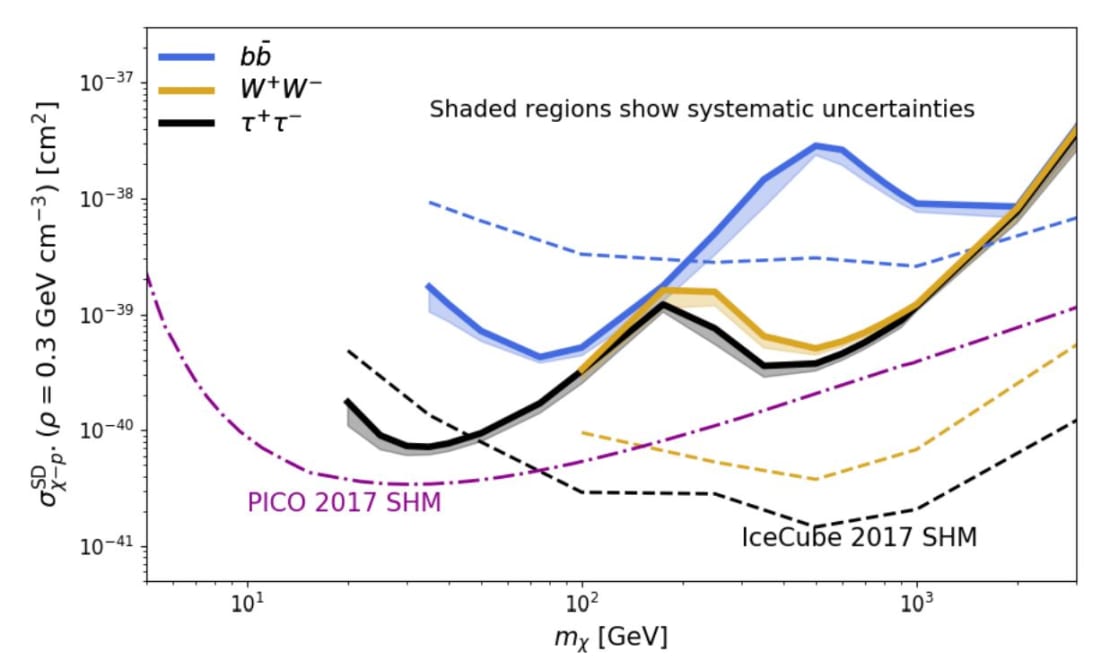Dark matter is one of the biggest mysteries in modern astronomy and physics. This enigmatic substance may constitute up to 85 percent of the matter in the universe, but scientists know very little about its properties and interactions. One of the primary theories today is that dark matter is made up of heretofore-undiscovered particles called weakly interacting massive particles, or WIMPs. As the name suggests, WIMPs interact very weakly and are therefore very difficult to detect. In fact, they haven’t yet been detected at all.
In the absence of detection, dark matter experiments can set constraints on properties of dark matter, which enable theoretical physicists to refine their models of the mysterious substance. These constraints usually depend strongly upon the expected distribution of the velocity of dark matter particles.
But recent astronomical observations pose challenges to our assumptions about the velocity distribution of dark matter in the vicinity of Earth, raising questions about the validity of many of the existing constraints. By combining observations from IceCube and PICO—a bubble chamber located underground at SNOLAB in Sudbury, Ontario, Canada—scientists can derive conservative constraints that are robust with respect to the assumptions on dark matter velocity.
In a paper recently submitted to the European Physical Journal C, scientists from IceCube and PICO determined new constraints on particle physics properties of dark matter. Though these are less stringent than previous constraints, they take into consideration the latest research on the distribution of dark matter in our galaxy.

When setting constraints given a lack of detection, scientists have to make some assumptions about how many dark matter particles there are and how fast and in what direction they are traveling. Dark matter experiments, including IceCube and PICO, often assume a Maxwellian equilibrium distribution in which the velocity distribution is the same in all directions (i.e., isotropic). Until now.
Recent astronomical observations suggest that our galaxy merged with something—perhaps tidal debris from a massive satellite galaxy of the Milky Way—about 4 billion to 6 billion years ago, which may have significantly perturbed the distribution of dark matter velocities, directions, and density. If so, the dark matter in our galaxy is not in equilibrium, and therefore many of the particle physics constraints that currently exist would disappear.
That’s where IceCube and PICO can help. IceCube looks for an excess of neutrinos at GeV energies from the direction of the sun; if they find a statistically significant excess, it would be conclusive evidence that dark matter is annihilating in the sun. Meanwhile, PICO looks for signatures of dark matter particles scattering off the nuclei in their “target mass,” the sensitive area of the detector; for PICO, this is a fluid called C3F8, normally used in refrigerators. These two experiments are sensitive to different parts of the velocity distribution and are thus complementary: IceCube is sensitive to slower dark matter particles, while PICO is more likely to detect faster ones. So when collaborators combine results from their respective experiments, they obtain reasonably stringent constraints on a property called the spin-dependent scattering cross section.
For the analysis outlined in this paper, IceCube and PICO collaborators described the distribution of velocities of dark matter particles in the solar rest frame as a sum over theoretical streams of fixed velocity and examined how the constraints from the two experiments evolved with respect to the stream velocity. They found that while such nonstandard velocity distributions for dark matter can significantly affect the particle physics constraints from individual experiments, they cannot escape IceCube and PICO simultaneously. This is especially true at low dark matter masses, where the constraints weakened by factors less than 10.
While these new constraints are not as good as the constraints under standard assumptions, they are more robust because they take into account more valid assumptions and astrophysical uncertainties.
WIMPs have been the focus of many dark matter experiments for the past 15 years. However, since none have been found yet, some researchers are beginning to wonder whether WIMPs are the answer after all. But in the mind of Niels Bohr Institute postdoc Mohamed Rameez, a lead on this paper, the reason we have not yet discovered WIMPs could be due to these various astrophysical uncertainties. “Only a detailed examination of the various search strategies and their complementarity can tell us how robust our constraints and exclusions are, or whether we have just been unlucky,” he says.
“I hope that the community will pay attention to this paper, and that our results will catalyze activity in the direction of understanding these complementarities.”
info “Velocity independent constraints on spin-dependent DM-nucleon interactions from IceCube and PICO,” IceCube Collaboration: M. G. Aartsen et al., Eur. Phys. J. C 80 (2020) 9, 819, https://link.springer.com, arxiv.org/abs/1907.12509